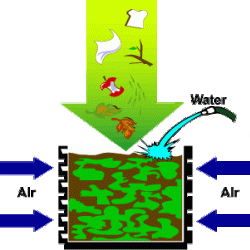Source Institutions
Source Institutions
Add to list Go to activity
Activity link broken? See if it's at the internet archive

In this activity (page 19 of the PDF) learners will create a soda bottle bioreactor by exploring the science of composting, comparing variables such as reactor design, moisture content, and nutrient ratios of mixtures to be composted. This was created as a post-visit activity for a workshop about garbage and recycling, but is also makes an excellent stand-alone activity.
- 10 to 30 minutes
- 1 to 12 months
- $10 - $20 per student
- Ages 8 - 14
- Activity
- English
Quick Guide
Materials List (per student)
- Two 2-liter or 3-liter soda bottles
- One smaller container, about 5-cm high, that fits inside the soda bottle
- One Styrofoam plate or tray
- Drill or nail for making holes (For Teacher Use Only)
- Duct tape or clear packing tape
- Utility Knife (For Teacher Use Only)
- Insulation materials such as sheets of fiberglass or foam rubber, or Styrofoam peanuts
- Fine-meshed screen or fabric large enough to cover top of soda bottle and air holes in bottom half
- Thermometer that will fit into the top of the soda bottle and be long enough to reach down into the center of the compost
- Chopped vegetable scraps such as lettuce leaves, carrot or potato peelings, and apple cores, or garden wastes such as weeds or grass clippings
- Bulking agent such as wood shavings or 1-2 cm pieces of paper egg cartons, cardboard, or wood
- Optional: Hollow tubing to provide ventilation
Subjects
-
Engineering and Technology
-
Engineering
- Environmental Engineering
-
Technology
- Agriculture and Biotechnology
-
Engineering
-
Life Sciences
-
Ecology
- Human Impact
-
Ecology
Informal Categories
- Food and Cooking
- Nature and Environment
Audience
To use this activity, learners need to:
- see
- read
- touch
Learning styles supported:
- Uses STEM to solve real-world problems
- Involves hands-on or lab activities
Other
Includes alignment to state and/or national standards:
This resource is part of:
Access Rights:
- Free access
By:
- Cornell Waste Management Institute
Rights:
- All rights reserved, COSI Columbus, 2009
